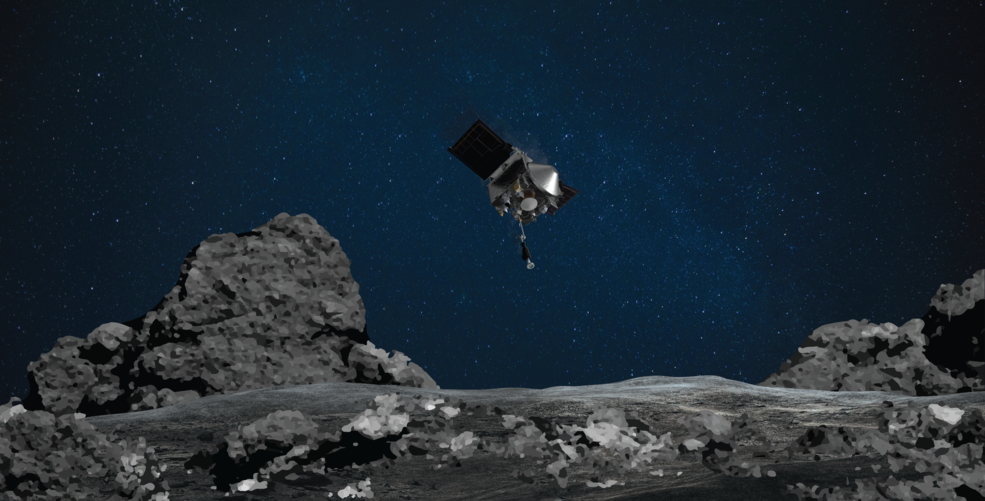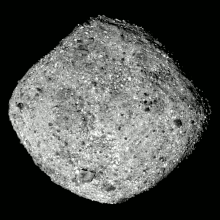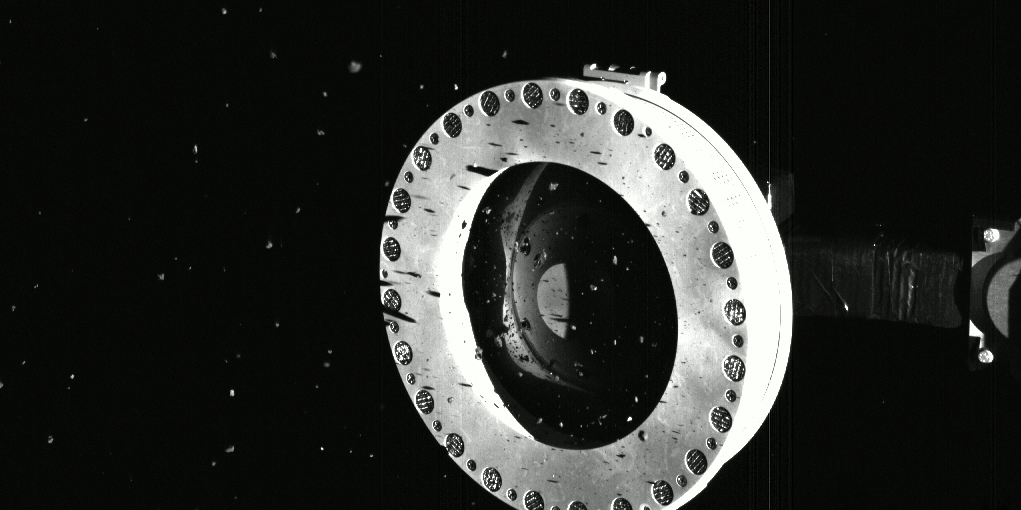It looks like you're using an Ad Blocker.
Please white-list or disable AboveTopSecret.com in your ad-blocking tool.
Thank you.
Some features of ATS will be disabled while you continue to use an ad-blocker.
21
share:

4 years into its 7 year mission NASA's sample collecting Spacecraft OSIRIS-REx is ready for its close up with Asteroid Bennu , if all goes to plan OSIRIS-REx will brush past Bennu and release a burst of nitrogen gas to loosen material which will be collected by OSIRIS-REx's sample collecting arm , NASA aim to recover about 60 grams of the asteroid which has been touring our Solar System since its formation some 4.5 Billion years ago.

NASA will have enough nitrogen gas for three attempts at collection but hopefully the first shot will be all that is needed before OSIRIS-REx sends its sample home while we wait untill 2023 for its arrival.
NASA will be live streaming the event which will take place between 1:20 to 6:30 p.m local Earth time.
Live stream animation displaying OSIRIS-REx’s sample collection activities in real time. The animation commences with the spacecraft’s slew into position for the Orbit Departure Maneuver and runs through the entire sequence of TAG events, concluding after the spacecraft’s back-away burn.
www.nasa.gov...
Events like this show just how brilliant we can be when we set our sights on something , touching a small moving rock 331,849,015 kilometers away and hopefully returning pieces of it home will be a mind blowing achievement.
Good luck chaps and chapesses.
NASA posted this short video back in August of a dry run for the maneuver they've planned to do on Tuesday.
Captured on Aug. 11 during the second rehearsal of the OSIRIS-REx mission’s sample collection event, this series of images shows the SamCam imager’s field of view as the NASA spacecraft approaches asteroid Bennu’s surface. The rehearsal brought the spacecraft through the first three maneuvers of the sampling sequence to a point approximately 131 feet (40 meters) above the surface, after which the spacecraft performed a back-away burn.
These images were captured over a 13.5-minute period. The imaging sequence begins at approximately 420 feet (128 meters) above the surface – before the spacecraft executes the “Checkpoint” maneuver – and runs through to the “Matchpoint” maneuver, with the last image taken approximately 144 feet (44 meters) above the surface of Bennu.
Interestingly Asteroid Bennu has 1-in-2,700 chance of impacting Earth
Maybe we are giving it a little nudge to make those odds a bit lower like a 1-in-10...Always found NASA's naming convention to be strange and very mysterious at best.
Osiris is the Egyptian Lord of the Underworld and Judge of the Dead and of course REX is king.
Bennu is the ancient Egyptian mythological bird associated with the Sun, creation, and rebirth.
I also love that Bennu is diamond shaped or that of a battered cube. S&F!
Maybe we are giving it a little nudge to make those odds a bit lower like a 1-in-10...Always found NASA's naming convention to be strange and very mysterious at best.
Osiris is the Egyptian Lord of the Underworld and Judge of the Dead and of course REX is king.
Bennu is the ancient Egyptian mythological bird associated with the Sun, creation, and rebirth.
I also love that Bennu is diamond shaped or that of a battered cube. S&F!
Thanks, Gortex!
By the way, and I don't think this was mentioned here, but there will be a media briefing on NASA TV about Tuesday's touch-and-go event today (Monday) at 3 PM U.S. Eastern time, 19:00 GMT.
Edit to add:
Here's a link giving information about the pre-event media briefings. Looking at this, I noticed there will also be a telephone media conference at 1 PM Eastern (17:00 GMT) as well as the 3 PM briefing, which is labeled in the link as a "Science and Engineering Televised Briefing."
www.nasa.gov...
By the way, and I don't think this was mentioned here, but there will be a media briefing on NASA TV about Tuesday's touch-and-go event today (Monday) at 3 PM U.S. Eastern time, 19:00 GMT.
Edit to add:
Here's a link giving information about the pre-event media briefings. Looking at this, I noticed there will also be a telephone media conference at 1 PM Eastern (17:00 GMT) as well as the 3 PM briefing, which is labeled in the link as a "Science and Engineering Televised Briefing."
www.nasa.gov...
Monday, Oct. 19
1 p.m. – Asteroid Science and Planetary Defense media teleconference with the following participants:
- Lori Glaze, Planetary Science Division director, NASA Headquarters, Washington
- Hal Levison, Lucy mission principal investigator, Southwest Research Institute, Boulder, Colorado
- Lindy Elkins-Tanton, Psyche mission principal investigator, Arizona State University, Tempe
- Andrea Riley, DART mission program executive, NASA Headquarters
- Jamie Elsila, research scientist at NASA Goddard Space Flight Center, Greenbelt, Maryland
For dial-in information, media should contact Alana Johnson at [email protected] no later than 11 a.m. Oct. 19.
3 p.m. – OSIRIS-REx Science and Engineering televised briefing with the following participants:
- Thomas Zurbuchen, associate administrator, Science Mission Directorate, NASA Headquarters, Washington
- Lori Glaze, Planetary Science Division director, NASA Headquarters
- Heather Enos, OSIRIS-REx deputy principal investigator, University of Arizona, Tucson
- Kenneth Getzandanner, OSIRIS-REx flight dynamics manager, Goddard
- Beth Buck, OSIRIS-REx mission operations program manager, Lockheed Martin Space, Littleton, Colorado
edit on 10/19/2020 by Soylent Green Is People because: (no reason given)
As mentioned above, here is a link to the first of two pre-event live telephonic media briefings for tomorrow's Touch-and-Go sample collection at
Bennu. This one is about Asteroid science and planetary defense. It's about to start.
There will be second briefing by the engineering team at 3 PM (Eastern time) today.
There will be second briefing by the engineering team at 3 PM (Eastern time) today.
edit on 10/19/2020 by Soylent Green Is People because: (no reason given)
LIVE Engineering Team Pre-event media conference about tomorrow's Touch-and-go sample collection:
edit on 10/19/2020 by Soylent Green Is People because: (no reason given)
a reply to: gortex
NASA work has occultic ritual level too.
The Anointed King of the underworld Osiris meets the Soul of the Sun God Ra.
As Above
So Below
4 years into its 7 year mission NASA's sample collecting Spacecraft OSIRIS-REx is ready for its close up with Asteroid Bennu , if all goes to plan OSIRIS-REx will brush past Bennu
NASA work has occultic ritual level too.
The Anointed King of the underworld Osiris meets the Soul of the Sun God Ra.
As Above
So Below
Objective complete ,now for the return
360 video that shows what OSIRIS-REx just did.
Preliminary data show that today's sample collection event went as planned 👍 More details to come once all the data from the event are downlinked to Earth. Thanks, everybody, for following along as we journey #ToBennuAndBack!
twitter.com...
360 video that shows what OSIRIS-REx just did.
NASA’s first asteroid sample return mission, OSIRIS-REx, will make a daring attempt to “TAG” asteroid Bennu on Oct. 20 – touch its surface and collect a sample for return to Earth. Experience the sample collection event in 360 and watch as OSIRIS-REx contacts the rocky surface of sample site Nightingale on Asteroid Bennu.
Here's a replay of the entire broadcast of the touch-and go (TAG) event, The whole thig is about 90 minutes long and includes the entire process of
the spacecraft making its maneuvers down toward the surface. But if you just want to watch the part when the TAG occurred, start watching at about
the 1:12:40 mark.
By the way, you might see images of the surface in this video, but please note that this is just an animated simulation; images from the actual event are not being processed in real time (although I suspect we will see images over the next couple of days).
By the way, you might see images of the surface in this video, but please note that this is just an animated simulation; images from the actual event are not being processed in real time (although I suspect we will see images over the next couple of days).
edit on 10/20/2020 by Soylent Green Is People because: (no reason given)
Am I the only person concerned about the fact that they are bringing samples from the asteroid directly back to earth? Didn’t anyone else see the
movie “Life”?
The capsule and the samples will be landing in “Utah”in 2023. Both the exterior of the capsule and the samples pose a potential contamination hazard to earth. Studies at Chernobyl have identified organisms that can thrive in the setting of both extreme heat and high levels of radiation...we have also identified organisms that can survive in extreme cold, under extreme pressure, etc....
www.popsci.com...
Anyone who has considered panspermia to be a viable theory should be concerned about this plan.
a reply to: gortex
The capsule and the samples will be landing in “Utah”in 2023. Both the exterior of the capsule and the samples pose a potential contamination hazard to earth. Studies at Chernobyl have identified organisms that can thrive in the setting of both extreme heat and high levels of radiation...we have also identified organisms that can survive in extreme cold, under extreme pressure, etc....
www.popsci.com...
Anyone who has considered panspermia to be a viable theory should be concerned about this plan.
a reply to: gortex
NASA have released footage of OSIRIS-REx's Touch and Go.
While the sample may contain organic molecules I doubt there will be microbes in there , even if there were I'm sure NASA will have taken that into consideration in the design of the return capsule , if there are microbes in there I doubt NASA would want to go all that way just to have them scattered across Utah.
a reply to: Buvvy
While the sample may contain organic molecules I doubt there will be microbes in there , even if there were I'm sure NASA will have taken that into consideration in the design of the return capsule , if there are microbes in there I doubt NASA would want to go all that way just to have them scattered across Utah.
It seems the sample collection went too well and OSIRIS-REx collected more material than expected , this has caused the cover of the sample collection
head to leak collected material , NASA will attempt to stow the remaining material sooner than planned.
"It's full to the brim Captain ... she cannae take anymore !"
Captured on Oct. 22, this series of three images shows that the Touch-and-Go Sample Acquisition Mechanism (TAGSAM) head on NASA’s OSIRIS-REx spacecraft is full of rocks and dust collected from asteroid Bennu. The image series also shows that some of these particles are slowly escaping the sampler head. Analysis by the OSIRIS-REx team suggests that bits of material are passing through small gaps where the head’s mylar flap is slightly wedged open. The mylar flap (the black bulge visible in the 9 o’clock position inside the ring) is designed to keep the collected material locked inside, and these unsealed areas appear to be caused by larger rocks that didn’t fully pass through the flap. Based on available imagery, the team suspects there is plentiful sample inside the head, and is on a path to stow the sample as quickly as possible.
www.asteroidmission.org...
"It's full to the brim Captain ... she cannae take anymore !"
a reply to: gortex
From the article you linked:
They were originally planning to do something innovative to further determine how much material they collected if they couldn't tell by looking. The "Sample Mass Measurement" was going to be done by putting the sample arm out as far as possible then spinning the spacecraft in a circle.
It would spin like a track-and-field hammer thrower. The characteristics of the spacecraft's spin would be compared to the way it spun on a similar baseline test in which the collection container was empty. By comparing the two spin activities, they would be able to determine the mass of stuff in the collection container.
Clever.
But as it says, they decided to forego that because they are highly confident the container is full enough, plus they want to stow it safely before losing more material.
From the article you linked:
To preserve the remaining material, the mission team decided to forego the Sample Mass Measurement activity originally scheduled for Saturday, Oct. 24...
They were originally planning to do something innovative to further determine how much material they collected if they couldn't tell by looking. The "Sample Mass Measurement" was going to be done by putting the sample arm out as far as possible then spinning the spacecraft in a circle.
It would spin like a track-and-field hammer thrower. The characteristics of the spacecraft's spin would be compared to the way it spun on a similar baseline test in which the collection container was empty. By comparing the two spin activities, they would be able to determine the mass of stuff in the collection container.
Clever.
But as it says, they decided to forego that because they are highly confident the container is full enough, plus they want to stow it safely before losing more material.
edit on 10/24/2020 by Soylent Green Is People because: (no reason given)
The sample of Bennu has been successfully stored ready for its return to Earth.
“Given the complexity of the process to place the sample collector head onto the capture ring, we expected that it would take a few attempts to get it in the perfect position,” said Rich Burns, OSIRIS-REx project manager at NASA's Goddard Space Flight Center in Greenbelt, Maryland. “Fortunately, the head was captured on the first try, which allowed us to expeditiously execute the stow procedure.”
By the evening of Oct. 27, the spacecraft’s TAGSAM arm had placed the collector head into the SRC. The following morning, the OSIRIS-REx team verified that the collector head was thoroughly fastened into the capsule by performing a “backout check.” This sequence commanded the TAGSAM arm to attempt to back out of the capsule – which tugged on the collector head and ensured the latches are well secured.
The OSIRIS-REx team will now focus on preparing the spacecraft for the next phase of the mission – Earth Return Cruise. The departure window opens in March 2021 for OSIRIS-REx to begin its voyage home, and the spacecraft is targeting delivery of the SRC to Earth on Sep. 24, 2023.
www.nasa.gov...
new topics
-
Results of the use of the Oreshnik missile system in Dnepropetrovsk
World War Three: 17 minutes ago -
Nigel Farage now the Most Favoured UK Politician
Regional Politics: 1 hours ago -
Little Johnny and Larry should team up
General Chit Chat: 8 hours ago -
Will Us use alien technology to fight in ww3?
World War Three: 8 hours ago
top topics
-
Elon Says It’s ‘Likely’ He Buys Tanking MSNBC
Political Ideology: 17 hours ago, 16 flags -
Little Johnny and Larry should team up
General Chit Chat: 8 hours ago, 5 flags -
Shane Gillis commercial
Jokes, Puns, & Pranks: 14 hours ago, 4 flags -
Will Us use alien technology to fight in ww3?
World War Three: 8 hours ago, 1 flags -
Nigel Farage now the Most Favoured UK Politician
Regional Politics: 1 hours ago, 1 flags -
Results of the use of the Oreshnik missile system in Dnepropetrovsk
World War Three: 17 minutes ago, 0 flags
active topics
-
Results of the use of the Oreshnik missile system in Dnepropetrovsk
World War Three • 2 • : RussianTroll -
Nigel Farage now the Most Favoured UK Politician
Regional Politics • 4 • : onestonemonkey -
Well we know Putins ICBMs won't fail in their silos
World War Three • 179 • : andy06shake -
Will Us use alien technology to fight in ww3?
World War Three • 10 • : andy06shake -
Why isn't Psychiatry involved?
Social Issues and Civil Unrest • 13 • : ADVISOR -
WATCH LIVE: US Congress hearing on UFOs, unidentified anomalous phenomena
Aliens and UFOs • 152 • : Lazy88 -
Biden's "Reckless" Decision To Escalate Russia-Ukraine War
World War Three • 123 • : BedevereTheWise -
Elon Says It’s ‘Likely’ He Buys Tanking MSNBC
Political Ideology • 74 • : andy06shake -
Montelukast affects brain, caused 5 year old to attempt suicide
Medical Issues & Conspiracies • 10 • : DeadlyStaringFrog -
Jaguar Rebrand Video Causes "WTF?" Moment - Seriously Weird
Automotive Discussion • 21 • : Athetos
21

